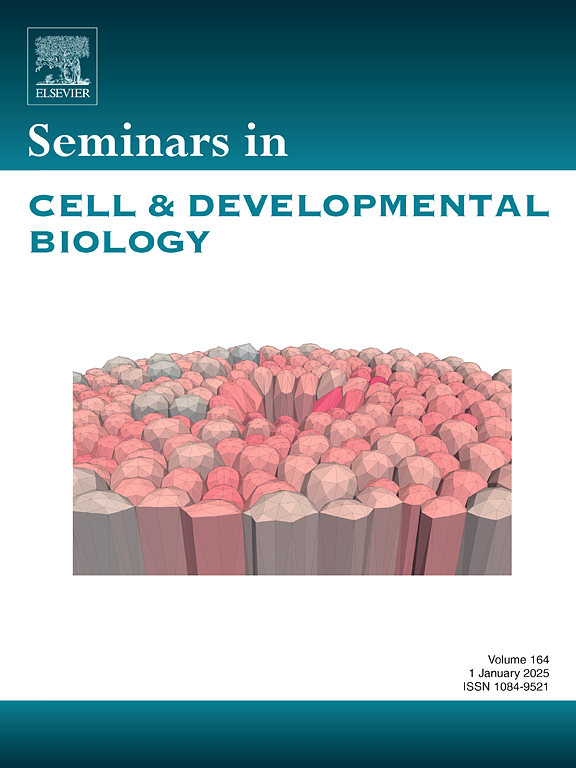工程卵巢生态位:体外卵泡发生的环境控制
IF 6
2区 生物学
Q1 CELL BIOLOGY
引用次数: 0
摘要
癌症治疗的进步显著提高了患者的生存率,但促性腺毒素治疗往往会损害生育能力,尤其是女性患者。虽然卵巢组织冷冻保存和移植是公认的保存生育能力的选择,但由于卵巢受累的风险,不推荐用于血源性癌症或高度转移性恶性肿瘤患者。在这些情况下,卵泡体外培养提供了一个有希望的选择。然而,卵泡发生是一个复杂的过程,需要细致的环境控制来模拟卵巢生态位。关键因素包括通过培养基传递的生化信号,三维生物材料或天然细胞外基质提供的生物物理支持,以及驱动卵泡发育的关键细胞相互作用。生物材料设计的最新进展导致支架的创造,不仅保持结构完整性,而且促进营养交换和细胞通讯。此外,与静态模型相比,动态培养系统显示出更好的结果,提供了一个更生理相关的环境。本文综述了体外卵泡形成过程中生物化学、生物物理和机械因素的相互作用。通过综合目前支架设计、培养系统和生物活性补充方面的创新,我们概述了优化体外卵泡发育的关键策略。这些进展为卵巢转移高风险患者提供更安全、更有效的生育保护方法铺平了道路,并为生殖生物学和再生医学提供了更广泛的见解。然而,为了充分发挥这一潜力,进一步的标准化、长期安全性研究和对新兴技术的批判性评估仍然是实现稳健的临床转化和个性化生殖应用的必要条件。本文章由计算机程序翻译,如有差异,请以英文原文为准。

Engineering the ovarian niche: Environmental control of folliculogenesis in vitro
Advancements in cancer therapies have significantly improved patient survival, but gonadotoxic treatments often compromise fertility, particularly in female patients. While ovarian tissue cryopreservation and transplantation are well-established fertility preservation options, they are not recommended for patients with blood-borne cancers or highly metastatic malignancies due to the risk of ovarian involvement. In these cases, follicle in vitro culture offers a promising alternative. However, folliculogenesis is a complex process that requires meticulous environmental control to mimic the ovarian niche. Key factors include biochemical signals delivered through culture media, biophysical support provided by three-dimensional biomaterials or the native extracellular matrix, and crucial cellular interactions that drive follicular development. Recent advances in biomaterial design have led to the creation of scaffolds that not only preserve structural integrity but also facilitate nutrient exchange and cell communication. Moreover, dynamic culture systems have shown superior outcomes compared to static models, offering a more physiologically relevant environment. This review explores the interplay of biochemical, biophysical, and mechanical factors in in vitro folliculogenesis. By synthesizing current innovations in scaffold design, culture systems, and bioactive supplementation, we outline key strategies for optimizing in vitro follicular development. These advances pave the way toward safer and more effective fertility preservation approaches for patients at high risk of ovarian metastasis and offer broader insights into reproductive biology and regenerative medicine. However, to fully realize this potential, further standardization, long-term safety studies, and critical evaluation of emerging technologies remain essential to enable robust clinical translation and personalized reproductive applications.
求助全文
通过发布文献求助,成功后即可免费获取论文全文。
去求助
来源期刊
CiteScore
15.10
自引率
1.40%
发文量
310
审稿时长
9.1 weeks
期刊介绍:
Seminars in Cell and Developmental Biology is a review journal dedicated to keeping scientists informed of developments in the field of molecular cell and developmental biology, on a topic by topic basis. Each issue is thematic in approach, devoted to an important topic of interest to cell and developmental biologists, focusing on the latest advances and their specific implications.
The aim of each issue is to provide a coordinated, readable, and lively review of a selected area, published rapidly to ensure currency.

 求助内容:
求助内容: 应助结果提醒方式:
应助结果提醒方式:


